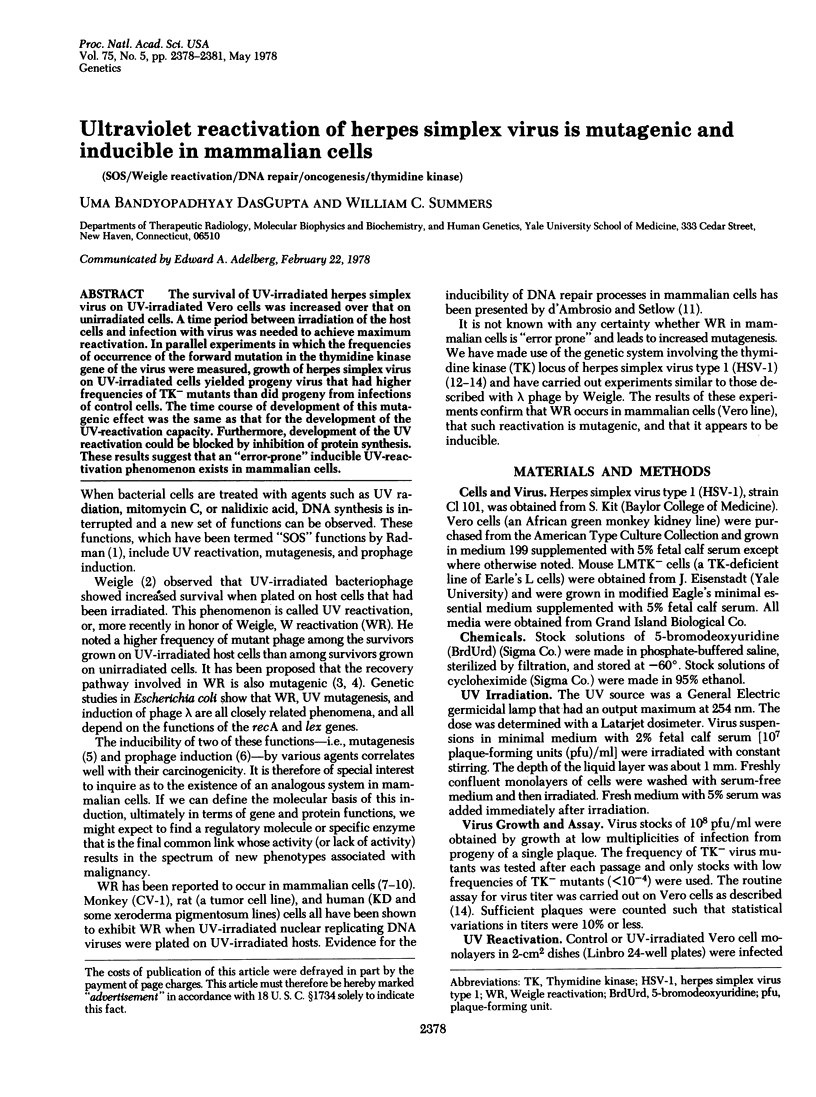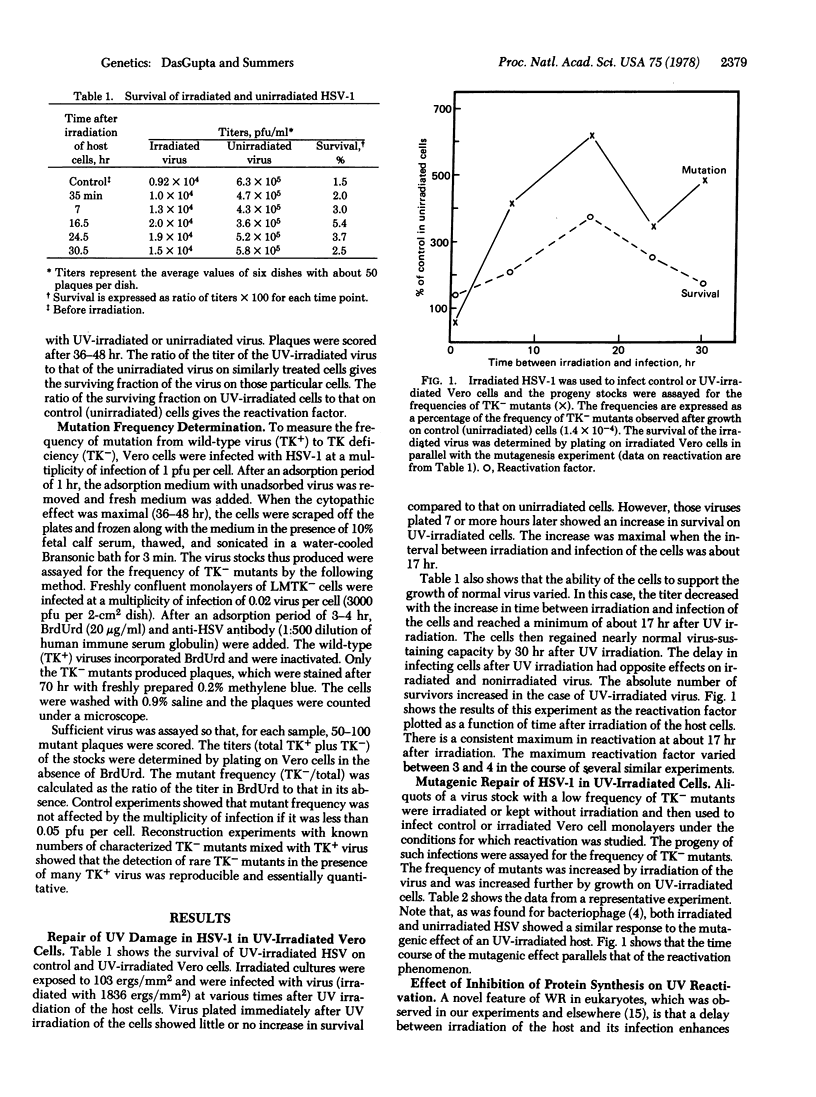Abstract
The survival of UV-irradiated herpes simplex virus on UV-irradiated Vero cells was increased over that on unirradiated cells. A time period between irradiation of the host cells and infection with virus was needed to achieve maximum reactivation. In parallel experiments in which the frequencies of occurrence of the forward mutation in the thymidine kinase gene of the virus were measured, growth of herpes simplex virus on UV-irradiated cells yielded progeny virus that had higher frequencies of TK- mutants than did progeny from infections of control cells. The time course of development of this mutagenic effect was the same as that for the development of the UV-reactivation capacity. Furthermore, development of the UV reactivation could be blocked by inhibition of protein synthesis. These results suggest that an "error prone" inducible UV-reactivation phenomenon exists in mammalian cells.
Full text
PDF



Selected References
These references are in PubMed. This may not be the complete list of references from this article.
- Ames B. N., Durston W. E., Yamasaki E., Lee F. D. Carcinogens are mutagens: a simple test system combining liver homogenates for activation and bacteria for detection. Proc Natl Acad Sci U S A. 1973 Aug;70(8):2281–2285. doi: 10.1073/pnas.70.8.2281. [DOI] [PMC free article] [PubMed] [Google Scholar]
- Bockstahler L. E., Lytle C. D. Radiation enhanced reactivation of nuclear replicating mammalian viruses. Photochem Photobiol. 1977 May;25(5):477–482. doi: 10.1111/j.1751-1097.1977.tb09173.x. [DOI] [PubMed] [Google Scholar]
- Bockstahler L. E., Lytle C. D., Stafford J. E., Haynes K. F. Ultraviolet enhanced reactivation of a human virus: effect of delayed infection. Mutat Res. 1976 Jun;35(2):189–198. doi: 10.1016/0027-5107(76)90184-6. [DOI] [PubMed] [Google Scholar]
- Cremer K. J., Summers W. C., Gesteland R. F. Cell-free synthesis of herpes simplex virus proteins. J Virol. 1977 Jun;22(3):750–757. doi: 10.1128/jvi.22.3.750-757.1977. [DOI] [PMC free article] [PubMed] [Google Scholar]
- D'Ambrosio S. M., Setlow R. B. Enhancement of postreplication repair in Chinese hamster cells. Proc Natl Acad Sci U S A. 1976 Jul;73(7):2396–2400. doi: 10.1073/pnas.73.7.2396. [DOI] [PMC free article] [PubMed] [Google Scholar]
- DUBBS D. R., KIT S. MUTANT STRAINS OF HERPES SIMPLEX DEFICIENT IN THYMIDINE KINASE-INDUCING ACTIVITY. Virology. 1964 Apr;22:493–502. doi: 10.1016/0042-6822(64)90070-4. [DOI] [PubMed] [Google Scholar]
- HYman R. W., Oakes J. E., Kudler L. In vitro repair of the preexisting nicks and gaps in herpes simplex virus DNA. Virology. 1977 Jan;76(1):286–294. doi: 10.1016/0042-6822(77)90303-8. [DOI] [PubMed] [Google Scholar]
- Hellman K. B., Haynes K. F., Bockstahler L. E. Radiation-enhanced survival of a human virus in normal and malignant rat cells. Proc Soc Exp Biol Med. 1974 Jan;145(1):255–262. doi: 10.3181/00379727-145-37788. [DOI] [PubMed] [Google Scholar]
- Ichikawa-Ryo H., Kondo S. Indirect mutagenesis in phage lambda by ultraviolet preirradiation of host bacteria. J Mol Biol. 1975 Sep 5;97(1):77–92. doi: 10.1016/s0022-2836(75)80023-4. [DOI] [PubMed] [Google Scholar]
- Lowy D. R., Rowe W. P., Teich N., Hartley J. W. Murine leukemia virus: high-frequency activation in vitro by 5-iododeoxyuridine and 5-bromodeoxyuridine. Science. 1971 Oct 8;174(4005):155–156. doi: 10.1126/science.174.4005.155. [DOI] [PubMed] [Google Scholar]
- Lytle C. D., Benane S. G., Bockstahler L. E. Ultraviolet-enhanced reactivation of Herpes virus in human tumor cells. Photochem Photobiol. 1974 Aug;20(2):91–94. doi: 10.1111/j.1751-1097.1974.tb06554.x. [DOI] [PubMed] [Google Scholar]
- Lytle C. D., Day R. S., 3rd, Hellman K. B., Bockstahler L. E. Infection of UV-irradiated xeroderma pigmentosum fibroblasts by herpes simplex virus: study of capacity and Weigle reactivation. Mutat Res. 1976 Sep;36(3):257–264. doi: 10.1016/0027-5107(76)90235-9. [DOI] [PubMed] [Google Scholar]
- Moreau P., Bailone A., Devoret R. Prophage lambda induction of Escherichia coli K12 envA uvrB: a highly sensitive test for potential carcinogens. Proc Natl Acad Sci U S A. 1976 Oct;73(10):3700–3704. doi: 10.1073/pnas.73.10.3700. [DOI] [PMC free article] [PubMed] [Google Scholar]
- Roberts J. W., Roberts C. W. Proteolytic cleavage of bacteriophage lambda repressor in induction. Proc Natl Acad Sci U S A. 1975 Jan;72(1):147–151. doi: 10.1073/pnas.72.1.147. [DOI] [PMC free article] [PubMed] [Google Scholar]
- Summers W. P., Wagner M., Summers W. C. Possible peptide chain termination mutants in thymide kinase gene of a mammalian virus, herpes simplex virus. Proc Natl Acad Sci U S A. 1975 Oct;72(10):4081–4084. doi: 10.1073/pnas.72.10.4081. [DOI] [PMC free article] [PubMed] [Google Scholar]
- Weigle J. J. Induction of Mutations in a Bacterial Virus. Proc Natl Acad Sci U S A. 1953 Jul;39(7):628–636. doi: 10.1073/pnas.39.7.628. [DOI] [PMC free article] [PubMed] [Google Scholar]
- Witkin E. M. Ultraviolet mutagenesis and inducible DNA repair in Escherichia coli. Bacteriol Rev. 1976 Dec;40(4):869–907. doi: 10.1128/br.40.4.869-907.1976. [DOI] [PMC free article] [PubMed] [Google Scholar]


